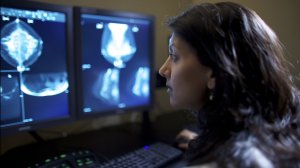A big breakthrough in the battle against breast cancer may have been found by a researcher in Connecticut.

The discovery was make by a local researcher and helped by a grant from the Terri Brodeur Breast Cancer Foundation with money raised by the Southern Connecticut Breast Cancer Walk.
It starts with hundreds of walkers every fall and ends in a lab.
The local fight against breast cancer is spearheaded by the foundation.
“I feel like a lot of us clinicians have insight into what’s going on with the disease type but it’s very hard to compete with people who are doing research full time,” said Dr. Erin Hofstatter, Yale Cancer Center. “Terri Brodeur has been valuable in giving me a chance.”
Hofstatter at the Yale Cancer Center is the latest star recipient of a grant from the foundation.
“I really enjoy my job taking care of women with breast cancer but it sure would be nice to be able to prevent it in the first place,” she said. “Why wait for the diagnosis.”
She said she went looking for new early indicators of an increased risk and and she may have found one by doing complex genetic aging tests on tissue samples from cancer patients and healthy women.
When she charted out the comparison, the results were clear.
“We were able to determine that the tissue marker in the women with breast cancer was older, if you will, it was aging prematurely, compared to women without breast cancer,” Hofstatter said.
If the trend continues in expanded studies, then they’ll look for a way to quickly test for prematurely aging breast tissue.
Hofstatter said she wants to make cancer screening more like how the risk of heart disease is tracked.
“They have cholesterol, blood pressure, other markers that measure risk that change over time, so if you take a medication and you see your cholesterol going down you can feel confident that your risk of having a heart attack is going down,” Hofstatter said. “So that if I say ‘here take Tamoxifin for prevention,’ I can show the woman that it’s working by lowering that biomarker risk. That is really where I’d love to go.”
“You’ve got to find somebody who believes in your story and is willing to put something out there for you and that’s what we’re providing to these young researchers,” said Stacey Gualtieri, The Terri Brodeur Breast Cancer Foundation.
Gualtieri said stories like Hofstatter’s are what keeps the foundation going.
The Southeastern Connecticut charity makes donors a unique promise. Sponsors cover overhead, donations go straight to grants.
“Every dollar goes to research,” Gualtieri said. “Every dollar, every penny, every fundraiser.”
In this case, those dollars went to Hofstatter who is now working to get her findings published.
“This was the seed money that I really needed to get started,” Hofstatter said. “Without it, I likely would not have pursued this project and we would not have found this out. I really hope it is the beginning of finding a biomarker that really works, is accurate and can really help a woman in the clinic find what she needs to prevent and treat her breast cancer.”
“We are doing good stuff and we’re making a difference and I think that’s the important thing that each researcher comes at it from a different angle and they are making strides in everything they do,” Gualtieri said.
Strides made thanks to each step taken, all of it bringing them closer to the finish line in the battle against breast cancer.





